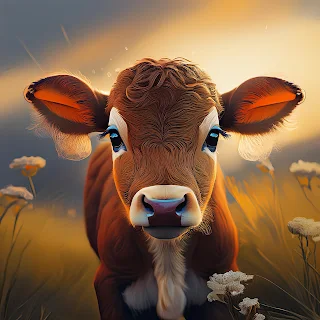Cows have been an integral part of human civilization for thousands of years, symbolizing sustenance, prosperity, and even spirituality in many cultures. Beyond their agricultural contributions, these gentle giants hold fascinating qualities that often go unnoticed. Let’s dive deeper into the world of cows and explore their significance, unique traits, and the role they play in the modern world.
A Friend of Humanity Through Ages
Cows were first domesticated around 10,000 years ago, marking a pivotal moment in human history. These animals became a cornerstone of agricultural societies, providing milk, meat, and labor. Civilizations across Mesopotamia, India, and Europe developed around their ability to sustain large populations through dairy and farming support.
In India, the cow is revered as a sacred symbol of life and motherhood, while in other parts of the world, it represents rural prosperity. Whether pulling plows or providing milk for essential nutrients, the cow’s contributions to human progress cannot be overstated.
The Science of the Cow
Did you know that cows are incredibly social animals? They live in herds and form strong bonds with other cows, displaying distinct personalities. Some are more dominant, while others may be playful or nurturing.
Cows are also surprisingly intelligent, capable of solving problems and remembering solutions for years. Research has shown they can recognize over 50 individuals, including humans and other cows, and they even display emotional responses, like excitement and sadness.
Physiologically, cows are ruminants, meaning they have a specialized digestive system with four stomach compartments. This allows them to break down tough plant materials like grass, turning it into high-quality protein products such as milk.
Sustainability and Cows
In today’s world, cows are at the heart of the sustainability debate. On the one hand, they provide food security for millions; on the other, concerns about their environmental impact, particularly methane emissions, prompt a need for sustainable practices.
Innovations such as methane-reducing feed, rotational grazing, and precision farming aim to minimize cows’ environmental footprint. Additionally, regenerative agriculture, which integrates cows to improve soil health, showcases how these animals can contribute to environmental solutions.
The Spiritual Connection
In many cultures, the cow is more than just livestock. In Hinduism, for example, the cow is a sacred animal, often associated with Kamadhenu, the mythical cow that fulfills all desires. Their gentle demeanor has made them symbols of non-violence and compassion.
In Celtic mythology, cows symbolized wealth and abundance, while African tribes considered them a form of currency. This deep reverence highlights the cow’s unique ability to nurture not just the body but also the soul.
Modern Challenges and Future Opportunities
As the global population grows, the demand for dairy and meat continues to rise. However, balancing this demand with environmental concerns is crucial. The future lies in sustainable practices, ethical farming, and innovations like lab-grown milk and plant-based alternatives.
Educating people about the importance of cows, their welfare, and their role in ecosystems can foster a more harmonious relationship between humans and nature.
Conclusion
The cow is much more than a farm animal. It is a symbol of sustenance, community, and resilience. Whether grazing peacefully in a field or being revered in temples, the cow reminds us of our deep connection to the natural world.
Let us honor this gentle giver by ensuring its welfare and preserving its place in our shared ecosystem. After all, the cow is not just part of our past—it is vital to our future.
See More








.jpeg)
0 Comments